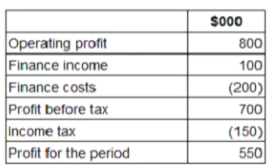Please select 3 correct answers
Explanation:
1. Depreciation is an expense recorded on the income statement, which reduces the company's profit for the year.
2. The loss on the disposal of PPE is also an expense recorded on the income statement, reducing the profit for the year.
3. Depreciation reduces the carrying value (book value) of PPE on the balance sheet, reflecting the decrease in the asset's value over time.
Explanation:
When a major customer goes into liquidation, likely, the amount XYZ expected to receive from them will not be paid. This means that the accounts receivable balance decreases because it's unlikely to be collected. Additionally, the allowance for doubtful debts or bad debts increases to reflect the potential loss from the liquidation.

Explanation:
Interest cover is calculated by dividing earnings before interest and taxes (EBIT) by the interest expense.
Explanation:
Prime cost is the sum of direct materials cost and direct labor cost. In this case, the prime cost can be calculated as:
Prime Cost = Direct Materials + Direct Labor
Prime Cost = $200,000 + $152,000
Prime Cost = $352,000
Explanation:
In the context of rising prices, using the LIFO method means that the older, cheaper inventory is assumed to be sold first, leaving the newer, more expensive inventory in the closing inventory. This results in the closing inventory being understated because it reflects the cost of older inventory rather than the current higher prices.
Please select 2 correct answers
Explanation:
A potential lender would want to assess the entity's ability to meet its financial obligations, such as interest payments, to ensure the loan will be repaid. Additionally, understanding the entity's long-term business plans provides insight into its future financial stability and ability to generate revenue.
The other options, past tax payments made by the entity, social policies of the entity, and dividend policy of the entity, are less relevant to a lender's decision-making process regarding lending to the entity.
Explanation:
The marginal cost per unit includes only the variable costs associated with producing one additional unit.
Advertisement
Explanation:
To calculate the selling price per unit using marginal cost-plus pricing, you add the desired margin percentage to the marginal cost per unit.
Given that the desired margin is 40%, and the marginal cost per unit is $33, the selling price per unit would be:
Selling price per unit = Marginal cost per unit + (Desired margin * Marginal cost per unit)
Selling price per unit = $33 + (0.40 * $33)
Selling price per unit = $33 + $13.20
Selling price per unit = $46.20
Explanation:
To find the net present value (NPV) of each project, you subtract the initial investment from the present value of the additional profit generated over the next five years.
For Investment 1:
NPV = Present value of additional profit - Initial investment
= $6,000 - $5,000
= $1,000
For Investment 2:
NPV = Present value of additional profit - Initial investment
= $5,500 - $4,000
= $1,500
Since Investment 2 has a higher NPV ($1,500), it is the best project. So, the net present value of the best project is $1500.
Explanation:
Not-for-profit organizations (NFPs) often have diverse objectives, ranging from providing social services to promoting cultural or environmental initiatives. Unlike for-profit entities, NFPs typically don't have shareholders expecting financial returns, and they often rely on diverse funding sources, including grants and donations, which may or may not be restricted. While some NFPs may face resource constraints, it's not accurate to generalize that they use resources inefficiently.
Explanation:
To calculate the production budget for month 1, we need to produce enough to cover sales for month 2 plus the desired closing inventory for month 1.
For month 2: 10% of 2,300 units = 230 units (desired closing inventory)
Total units needed for month 1 = 2,300 units (for month 2) + 230 units (closing inventory for month 1) = 2,530 units
So, the production budget for month 1 is 2,530 units - 936 units (beginning inventory) = 1,594 units.